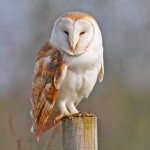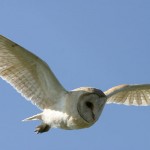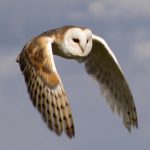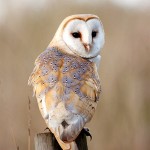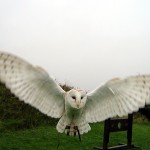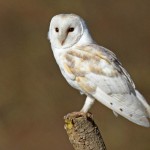The Barn Owl is one of the most enigmatic birds globally, often linked to ominous symbols and associated with death. The bird is also the most widely disseminated and is found all over the world.
The owls make a funny sound that can be heard kilometres away in the night. They have deep sited eyes with a distinct colour of white heart shaped on the face with ears hidden and not on the same level for left and right.
The owl has also been christened many names including white owl, monkey faced owl, night owl, death owl, rat owl, cave owl etc.
Appearance :
The Barn owl has deep sited eyes surrounded by a white heart shaped colour on the face. The rest of the body has rich dark colour coat in contrast with the white colour on the face. The size of the owls might be different from one to the other.
The average size of the male might be between 25 and 40 cm long with the wings spanning approximately 50 cm in length. They weigh on average 1/2kg for most species. They may be confused with a large white bird when in movement in the air.
The male owl is generally whiter than the female. The eyes of the bird are fixed and cannot move, if it has to see sideways it has to turn the whole head.
The female bird measures just about 40 cm long and weighs slightly just over 1/2kg. The bird features a reddish coloration on the chest and more spotted than the male counterpart. The spots signify the quality of the female.
The more the spots, the more resistant the female would be to parasitic flies and may be resistant to attacks from diseases. The female owl will normally lay about 5 to 7 eggs and will take just about 30 to 35 days before they hatch.
The youngsters are called as owlets and are normally pure white for about 6 days which gradually develops into its true colours in about 50 days or so.
Diet :
The Barn owl feeds on rats, moles, mice, squirrels, small birds plus other small animals. Since they do not have teeth with them, they normally swallow the prey wholesome. If the prey is larger that they can swallow, then they have to cut it into small pieces before enjoying their meals.
The bird will after sometime bring back the food to remove undigested parts like bones, feathers, nails etc. The bird has two chambers in its stomach. The first chamber takes in the food that has been swallowed while the second chamber takes in the juices.
Once the separation of the food stuff has been done between the juices and the indigestible foods is done, the latter are spit out though the mouth.
Breeding :
The female Barn Owl lays up to 7 eggs which it nests on top of a hollow tree. The eggs will hatch after roughly one month. Unlike other birds, the male owl normally assists the female in feeding the young ones. The chicks are able to fend for themselves or fly after 12 weeks of age.
Predators :
The bird is also hunted down by Fox, Wild dogs and Raccoons.
Life Cycles & Lifestyle :
The males will normally initiate the mating by making calls to their opposite sex. They will then lure the female with screeching calls. The female will generally lay about 5 eggs on old buildings, open woodlands or hollows in trees. Within a month the owlets will be hatched and will be fed by both parents. After about two months the owlets can now hunt on their own.
Facts :
| Scientific Name | Tyto Alba |
| Kingdom | Animalia |
| Phylum | Chordata |
| Class | Aves |
| Order | Strigiformes |
| Family | Tytonidae |
| Genus | Tyto |
| Diet | Carnivore |
| Size | 20cm to 40 cm |
| Wing Span | 80 cm to 120 cm |
| Weight | 300 grams to 500 grams |
| Lifespan | 5 years to 10 years |
| Lifestyle | Solitary |
| Conservation | Least concern |
| Colour | Black, White, Grey, Orange, Brown |
| Skin | Feathers |
| Food | Rats, Moles, Small birds |
| Habitat | Woodland and open grounds |
| Predators | Fox and Wild dogs |
Special Features :
White heart shaped face and deep sited eyes. The position of the ears of the owl are also distinctive than any other bird out there. One opening of the ear is apparently higher than the other.
These features enable the bird to be able to accurately hunt down its prey even low on the ground. The bird has a facial disk with it that directs the sounds to its ears. The time that takes the particular sound to reach the ear determines that direction of the prey.
To accurately determine where the sound is coming from is also the strength of the sound. This bird has also been associated with all the bad things happening including witchcraft, bad omens and even death.
Also read: Top 10 Most Expensive Birds in the World: Check it Out
Habitat :
The Barn Owls live in open spaces like woodland, old buildings, deserts, mashes, large empty fields or strips of forests. The birds in pairs require a large open space for breeding estimated at about 20 to 25 km of empty fields. The owls would mostly prefer large empty spaces with lots of rodents like rats that they feed on. Most of the birds prefer having a permanent position especially near water sources that they can hunt for their prey well.
Images, Pics, Photos and Pictures of Barn Owl :
They are nocturnal and only come out at night to hunt for their prey. Though if they have siblings they will be seen during the day when they come to feed them. When hunting they are very swift and will catch their prey unawares with their long and slim feet.
The prey will not notice the presence of the owl as it does not make any noise when flying. The owls have the best hearing abilities and will know the presence of their prey by sound only.
They also posses’ night vision capabilities that make them be able to hunt their prey even at night fall. The owl ability to catch their prey in total darkness has been tested and proven by catching a mouse in total darkness in the laboratory or deeply hidden in the thick of vegetation.

